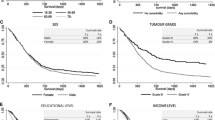Abstract
The incidence of glioblastoma multiforme (GBM) varies across the world and also within subpopulations within each nation. Many cancers show correlation with socioeconomic status and we hypothesised that incidence of GBM also does the same. We performed a retrospective analysis of all patients treated with brain tumours at a single hospital over a 6-year period. For these patients we examined markers of socioeconomic status and reviewed their histopathological diagnosis. A total of 2859 patients had surgery between April 2006 and April 2012. Of these 880 had histological diagnosis of GBM. Records for all patients were reviewed. Based on postcodes, socioeconomic data was obtained at ward level from government sources. Markers were: average weekly household income, percentage unemployed, population density, indices of deprivation and percentage of households with no car. Data was analysed for trends between incidence per ward and socio-economic markers. Increasing incidence of GBM was associated with increasing wage (p = 0.044), less unemployment (p = 0.0002), Indices of Multiple Deprivation (p = 0.05), lower population density (p = 0.0015) and greater ownership of cars (p = 0.0005). There are unique socioeconomic characteristics for patients with GBM. Although a link to aetiology cannot be established from this limited epidemiological study, these results identify issues that these patients are more likely to face. These should be taken into account when planning support services and patient care following surgery.





Similar content being viewed by others
References
Faggiano F, Partanen T, Kogevinas M, Boffetta P (1997) Socioeconomic differences in cancer incidence and mortality. In: Kogevinas M, Pearce N, Susser M, Boffetta P (eds) Social inequalities and cancer. IARC, IARC Scientific Publications, Lyon, pp 165–176
Preston-Martin S, Mack W, Henderson BE (1989) Risk factors for gliomas and meningiomas in males in Los Angeles County. Cancer Res 49:6137–6143
Brownson RC, Reif JS, Chang JC, Davis JR (1990) An analysis of occupational risks for brain cancer. Am J Public Health 80:169–172
Navas-Acien A, Pollan M, Gustavsson P, Plato N (2002) Occupation, exposure to chemicals and risk of gliomas and meningiomas in Sweden. Am J Ind Med 42:214–227
Inskip PD, Tarone RE, Hatch EE, Wilcosky TC, Fine HA, Black PM, Loeffler JS, Shapiro WR, Selker RG, Linet MS (2003) Sociodemographic indicators and risk of brain tumours. Int J Epidemiol 32:225–233
Galobardes B, Shaw M, Lawlor DA, Lynch JW, Smith GD (2006) Indicators of socioeconomic position (Part 1). J Epidemiol Community Health 60:7–12
Census. Office for national statistics. http://www.ons.gov.uk/ons/guide-method/census/2011/index.html. Accessed 24 Sep 2014
Louis DN, Ohgaki H, Wiestler OD, Cavenee WK (eds) (2007) World health organization classification of tumours of the central nervous system. IARC, Lyon
Curado MP, Edwards B, Shin HR, Ferlay J, Heanue M, Boyle P, Storm H (2009) Cancer incidence in five continents, volume IX. IARC Scientific Publication, Lyon
Fan KJ, Pezeshkpour GH (1992) Ethnic distribution of primary central nervous system tumors in Washington, DC, 1971 to 1985. J Natl Med Assoc 84:858–863
Inskip PD, Linet MS, Heinman EF (1995) Etiology of brain tumors in adults. Epidemiol Rev 17:382–414
Kuratsu J, Takeshima H, Ushio Y (2001) Trends in the incidence of primary intracranial tumors in Kumamoto, Japan. Int J Clin Oncol. 6:183–191
Malmer B, Grönberg H, Bergenheim AT, Lenner P, Henriksson R (1999) Familial aggregation of astrocytoma in northern Sweden: an epidemiological cohort study. Int J Cancer 81(3):366–370
Malmer B, Iselius L, Holmberg E, Collins A, Henriksson R, Grönberg H (2001) Genetic epidemiology of glioma. Br J Cancer 84(3):429–434
Tseng MY, Tseng JH, Merchant E (2006) Comparison of effects of socioeconomic and geographic variations on survival for adults and children with glioma. J Neurosurg 105(4 Suppl):297–305
Author information
Authors and Affiliations
Corresponding author
Ethics declarations
Conflict of interest
None.
Rights and permissions
About this article
Cite this article
Muquit, S., Parks, R. & Basu, S. Socio-economic characteristics of patients with glioblastoma multiforme. J Neurooncol 125, 325–329 (2015). https://doi.org/10.1007/s11060-015-1913-z
Received:
Accepted:
Published:
Issue Date:
DOI: https://doi.org/10.1007/s11060-015-1913-z




